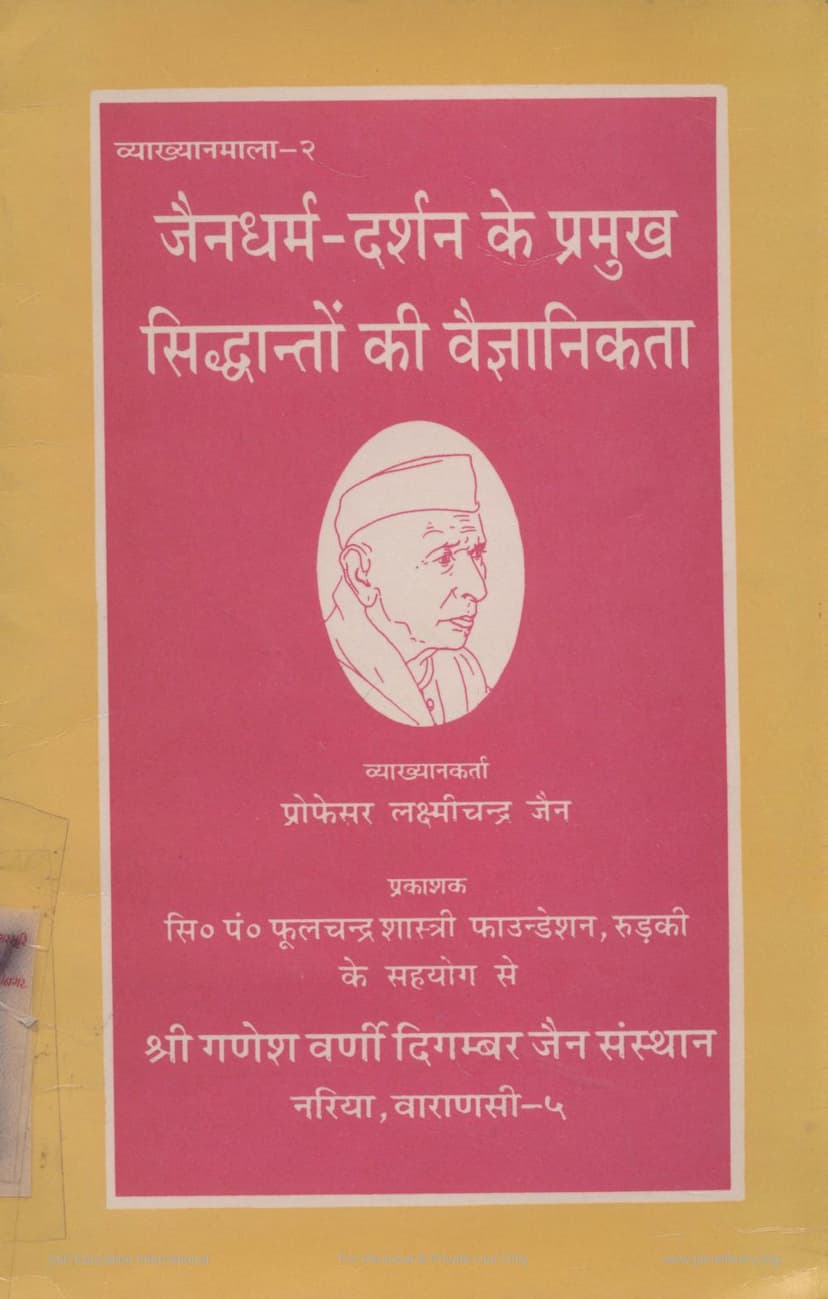Jain Dharm Darshan Ke Pramukh Siddhanto Ki Vaignanikta
Added to library: September 1, 2025

Summary
This document is a publication of a lecture series titled "The Scientificity of the Main Principles of Jainism-Philosophy" (Jain Dharma-Darshan ke Pramukh Siddhānton ki Vaigānikatā) by Professor Laxmichand Jain. It was published by Shri Ganesh Varni Digambar Jain Sansthan in Naria, Varanasi, with the support of the Sidhantacharya Pt. Phoolchandra Shastri Foundation, Roorkee. The first edition was released in September 1996.
The lectures were delivered by Professor Laxmichand Jain, a renowned mathematician and scientist, who is also the honorary director of the Acharya Vidyasagar Research Institute in Jabalpur. The convener of the lecture series was Dr. Phoolchandra Premi.
Key Themes and Summary of the Lectures:
The core idea of the lectures is to demonstrate the scientific basis and relevance of the fundamental principles of Jainism in the modern era. The publication aims to bridge the perceived gap between religion and science.
Introduction and Context (Page 11-12): The introduction begins by addressing common criticisms that create a divide between religion and science, such as religion being based on faith versus science on facts, religion relying on emotion versus science on objectivity, and religion preserving the status quo versus science embracing change. However, it then introduces Albert Einstein's perspective that "science without religion is lame and religion without science is blind," highlighting the complementary nature of both. The lectures propose that Jainism uniquely integrates both by providing objective study that is deeply scientific.
Objective Study (Page 10, 19-29):
The lectures delve into various aspects of Jainism and present their scientific underpinnings:
- Language and Scriptural Science (Page 12-15): The lectures discuss the scientific nature of language and scriptural knowledge in Jainism, including the evolution of writing systems like Brahmi and Sundari, potentially influenced by Indian and Greek scripts. The importance of "Shruta" (scriptural knowledge) and the "Dwadasanga" (twelve limbs of Jain scripture) are highlighted, along with the fourteen "Purvas" which contained a vast repository of knowledge across various disciplines.
- Proof and Epistemology (Page 15-18): The scientific methodology of "Pramana" (means of knowledge) and "Naya" (standpoints) is explained. The lectures emphasize the scientific rigor of the Jain syllogistic reasoning, particularly "Anekantavada" (non-absolutism) and "Syadvada" (conditional predication), which are presented as sophisticated systems for understanding reality from multiple perspectives. The concepts of mathematical logic, infinite sets, and their development within Jain texts are discussed, drawing parallels with modern mathematical concepts.
- Cosmology and Astronomy (Page 18-20): The "Triloka Prajnapti" and other cosmological texts are presented as having a scientific basis in geography, astronomy, and cosmology. The lectures detail the Jain understanding of units of space and time, astronomical calculations, and the formation of the universe, asserting that these concepts can be studied as historical developments of scientific models.
- Physics and Matter (Page 20-22): The Jain concept of "Pudgala" (matter) is analyzed from a physics perspective, including its atomic structure, creation, and annihilation. The intricate mathematical descriptions of karmic matter and its interaction with the soul are discussed, suggesting that they are akin to modern system theory and cybernetics.
- Ayurveda and Health (Page 21-23): The Jain approach to Ayurveda is examined, emphasizing principles of non-violence and vegetarianism. The lectures discuss the Jain contributions to medical texts, the avoidance of meat and alcohol in treatments, and the focus on herbal and mineral-based remedies. The scientific principles behind dietary restrictions and their impact on health and the environment are highlighted.
- Jain Arts and Sciences (Page 23-26): The scientific and mathematical foundations of various Jain art forms, including architecture, sculpture, and painting, are explored. The precise proportions and measurements used in Jain temple construction and idol making are presented as examples of applied science. The lectures also touch upon Jain music, poetry, and their underlying structures.
- Karma Theory (Page 25-29): The Jain Karma theory is presented as a complex system with scientific and mathematical underpinnings, dealing with cause and effect. The lectures discuss the stages of karmic bondage, its dissolution, and the scientific processes involved in spiritual development, equating them to modern concepts of system theory and cybernetics. The role of meditation and its scientific application in overcoming karmic obstacles is also discussed.
Subjective Study (Page 25-29): This section focuses on the internal, spiritual aspects of Jainism. It discusses the "Karana Traya" (three causal processes) and their role in spiritual advancement, particularly in dispelling "Moha" (delusion) and achieving liberation. The scientific nature of these internal processes, involving the purification of the mind and soul, is emphasized. The lectures connect these spiritual practices to the scientific understanding of the mind and consciousness.
Conclusion (Page 29-31): The concluding remarks reiterate the scientific essence of Jainism. It emphasizes that true happiness comes from knowledge and self-realization, free from attachment to external objects. The lectures highlight that Jainism's scientific approach extends to promoting universal well-being, influencing social, political, and economic spheres, and advocating for a lifestyle based on non-violence and environmental harmony. The pursuit of knowledge and spiritual development is presented as a scientific path to ultimate freedom and bliss.
In essence, "The Scientificity of the Main Principles of Jainism-Philosophy" aims to showcase Jainism not just as a spiritual or ethical system, but as a profound and scientifically rigorous framework for understanding the universe and achieving spiritual liberation. It highlights the ancient Jain tradition's sophisticated knowledge in mathematics, cosmology, physics, and psychology, demonstrating its enduring relevance in the modern scientific age.